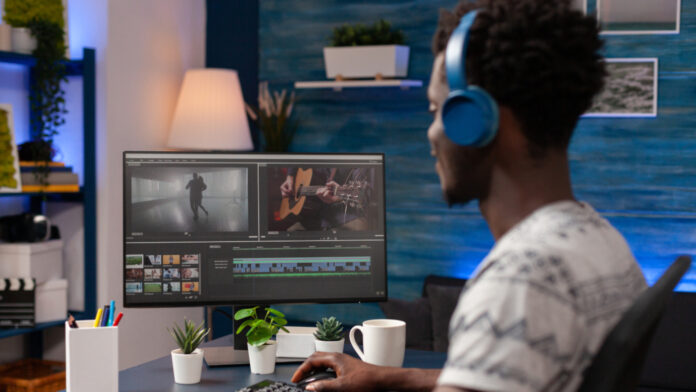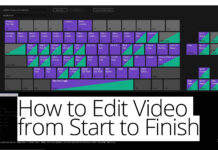In a nutshell
- Post-production plays a pivotal role in filmmaking, transforming raw footage into a cohesive narrative by editing the video, mixing sound and adding visual effects.
- Key roles in post-production, such as video editors, sound designers, colorists and visual effects artists, contribute significantly to the final product.
- Filmmaking is a collaborative effort with substantial input from all stages of the process, including directors, producers and actors, who continue to contribute even during the post-production phase.
Think about the world of filmmaking: What roles come to mind? Actors? Directors? Screenwriters? These are the most commonly thought of roles, and while these roles are incredibly important to the process of filmmaking, they don’t represent the whole production. In reality, the filmmaking process really comes together in the post-production phase. During production, the crew is focused on gathering all the pieces that the post-production team will later craft into the final production.
This article aims to shed light on all the pivotal roles of post-production and underscore the substantial value they lend to the projects they work on. Let’s get started.
First, what exactly is post-production?
Before we dive into the specific roles, let’s take a moment to define what post-production is. Post-production is the stage in filmmaking and video production that occurs after shooting has ended, where the raw footage is edited, sound is mixed, visual effects are added and a final narrative is crafted. Ultimately, post-production encompasses all footage editing, sound design, color grading and visual effects on productions.
The roles in post-production are the specialized positions that handle these tasks, ensuring that the final product captivates and resonates with audiences. So, let’s take a look at some of the most vital roles in post-production.
Main roles in post-production
Video editor
Video editors do more than cut footage; they are the unsung heroes of storytelling. Working in close coordination with the director and cinematographer, editors take on the task of sculpting raw footage into a fluid narrative by making precise cuts and arranging the footage in a coherent manner. For example, Martin Scorsese has worked with legendary editor Thelma Schoonmaker for over 40 years. Schoonmaker does more than cut Scorsese together; she collaborates with him throughout the editing process, directly including the visual narrative of the films.

Editors do more than piece clips together. They set the tone, the pacing and the organization of scenes. Imagine a music video with an electrifying montage sequence that perfectly captures the rhythm and energy of the song. It’s the editor to select those shots and stitches them together. Editors also bring life to dialogue scenes by organizing and trimming them, determining the film’s pacing and storytelling.
The work of a good editor is often seamless and difficult to pinpoint. But this often invisible craft underscores the role of an editor as one of the most pivotal in post-production, shaping the rhythm, tone and overall impact of the final product.
Sound designer
The sound designer is responsible for creating, selecting and assembling the sound elements of a film. These elements include dialogue, sound effects (often created through a technique called Foley), and background sounds or ambiance.
The sound designer’s work enhances the film’s overall quality by providing an immersive auditory experience that complements the visual narrative. This includes carefully matching the sounds with the on-screen action, a process known as synchronization, which is essential for maintaining the film’s continuity and enhancing its realism.
Furthermore, the sound designer contributes to the storytelling by using sound to evoke specific emotions or underline important plot developments. This could be as subtle as amplifying the background noise to create a sense of unease in a suspenseful scene or as noticeable as crafting the booming sound effects in an action sequence.
Sound design encompasses a variety of roles, each as necessary and interconnected as the last. So, let’s take a quick look at some of the other important roles in and around sound design.
Sound editor
While the roles of a sound editor and a sound designer may seem similar, they each serve unique functions in the filmmaking process. The sound editor is primarily responsible for sourcing and gathering the necessary sounds for the film. The sound designer later takes these sounds and integrates them into the production.
Sound mixer
A sound mixer uses professional audio equipment to monitor and carefully record all sound on set during production. Productions often use a handful of sources to produce a cohesive final sound, including a blend of dialogue, room sound and more.
Foley artist
Under the guidance of the sound mixer, Foley artists use various props and techniques to create and record ‘everyday’ sounds for a production. This includes things like footsteps, rainfall or even the rustling of clothing. Foley artists add subtle depth and realism that help audiences immerse themselves in the work.
Colorist

In filmmaking, a colorist plays a critical role in defining the visual aesthetics of the film. They use a process known as color grading to manipulate and enhance the colors of the footage, which in turn sets the overall mood and tone of the film.
For example, in a heartfelt drama, a colorist might use warm, earthy tones to create a feeling of comfort and intimacy. On the other hand, in a thriller, they might employ cool, desaturated tones to build an atmosphere of suspense and tension.
A colorist’s ability to carefully adjust colors allows them to establish specific moods and ensure visual consistency throughout the film. Their skills transform raw footage into a visually coherent and appealing narrative that supports the story and enhances the viewer’s experience.
Visual effects artist (VFX/FX)
A visual effects artist, often referred to as a VFX artist, is an integral part of the filmmaking process. They are responsible for creating and integrating computer-generated imagery (CGI) into live-action footage. This role is essential in films where it would be impractical or impossible to capture certain scenes using traditional filming techniques.
Visual effects artists work closely with the director and production team to enhance the film’s visual narrative, allowing filmmakers to do what they couldn’t do on set.
As with sound design, visual and special effects design encompasses a distinct set of vital post-production roles. Let’s take a look at what those roles are.
Roto/paint artist
Rotopaint artists meticulously and painstakingly trace and cut shots that will later be filled in with CGI.
Matte painter
Matte painters — so named for their traditional role of painting matter backdrops and physical set pieces — create additional filming environments from living rooms to fantastical cloud-top castles. This is accomplished through a combination of digital painting, photo manipulation, 3D sculpting and more.
Compositor
A compositor plays the crucial role of combining visual elements from separate sources into single images, often to create the illusion that all those elements are parts of the same scene. Their work is integral to seamlessly integrating various layers of special effects, CGI and live-action footage, creating a cohesive and believable visual narrative.
Visual and special effects is an ever-developing field with new and extended roles therein. Some FX teams can even include animators, 3D modelers and more.
Director/Producer
While not exclusively tied to post-production, the director and producer exert significant influence during this phase.
These key figures continue after filming to make crucial decisions, offer creative input and oversee the overall vision of the film. From approving edits to providing feedback, their guidance shapes the final product. These roles collaborate closely with the post-production team, ensuring that the film aligns with their creative vision and resonates with the intended audience.
Cinematographer
Although primarily associated with capturing stunning visuals on set, the cinematographer’s role extends into post-production. Collaborating with the colorist, they craft the film’s visual style and maintain consistency throughout the project.
The cinematographer’s choices in lighting and camera techniques influence the overall look and feel of the film. By working with the post-production team through to the finish, the cinematographer, like the director, can see through design choices to the end and into a cohesive final product.
Actors

While actors’ primary contribution is in front of the camera, their performances can play a crucial role in post-production. Post-production sometimes calls for reshoots when recorded work doesn’t pan. In this event, and even without reshoots, actors are often recalled to record audio in a process called ADR, or Automated Dialogue Replacement.
Just a glimpse inside the editing room
Post-production artists like editors, sound designers, and FX artists shape the visual and auditory aspects of a film, transforming raw footage into a cohesive cinematic masterpiece. From editors stitching together captivating sequences to sound designers creating immersive soundscapes, each role contributes to the final product in their unique ways. So, as you enjoy your next movie, take a moment to appreciate the collaborative efforts of these talented individuals working tirelessly behind the scenes.








